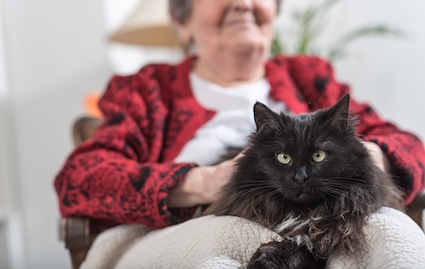Can you have a pet at a retirement community? Many seniors considering a move want to take their friend along. Or perhaps they want the ability to get a companion later. Fortunately, more assisted living facilities allow pets than in the past. Along with the trend comes some restrictions seniors should know about in understanding their options.
Over the last decade, there’s been a noticeable shift toward pet-friendly policies as communities recognize the benefits of allowing pets on the property. For example, a recent Seniors Guide look at retirement communities in Columbus, Ohio, showed that all of the communities that offered assisted living also had pet-friendly policies. Assisted living facilities where pets are allowed contribute to a positive community life.
Reasons for the trend
 Senior living communities have noted the benefits of pets, both to residents and to their own success.
Senior living communities have noted the benefits of pets, both to residents and to their own success.
For residents, pets contribute to emotional, mental, and physical health.
Emotional and mental benefits
Pets reduce loneliness and depression. They can increase a person’s serotonin level, boosting this feel-good hormone. Pet ownership can lower anxiety, stress, cholesterol, and blood pressure levels. Having a pet as a companion helps alleviate loneliness, especially for a senior who has recently lost a partner.
In addition, caring for pets gives a person a sense of purpose and contributes to a routine, through feeding, walking, and playing with the little buddy.
Physical benefits
Dogs encourage physical activity, since they need to be walked for exercise and potty breaks. This keeps seniors active and moving, which helps them stay mobile and burn calories.
Social benefits
Since so many people appreciate a friendly pet, taking a dog out for a walk or other public outing can give the senior a chance to mix and mingle with others.
Benefits to the community
The assisted living facilities where pets are allowed know this helps them appeal to the many seniors who view pets as family. They also recognize the benefits of pets to their residents’ well-being.
 To spread these benefits to residents that don’t own pets, some facilities bring in furry companions that share the love and the limelight, including therapy animals or other visiting four-legged friends.
To spread these benefits to residents that don’t own pets, some facilities bring in furry companions that share the love and the limelight, including therapy animals or other visiting four-legged friends.
One heartwarming example is The Philomena, an assisted living facility in Kyle, Texas. In early 2025, residents collectively adopted a rescued Shih Tzu named Chewy, who became their “executive dog.” Chewy visits during weekdays, boosting moods and encouraging social interaction, especially among residents with Alzheimer’s or dementia. Staff are hoping to certify him as an official therapy dog because of the positive impact he’s had on the community.
What to know about pets at assisted living facilities
While policies vary by facility, many now allow small dogs, cats, birds, or other small pets. The communities typically place size or breed restrictions and require a pet deposit or proof that the resident can care for the animal. Some also offer pet therapy programs or on-site dog-walking services.
If you’re considering a move to a community that allows pets, ask for details before deciding if that location is a good fit. Ask questions such as:
- What pets are allowed – both types of pets and breeds?
- Are there size restrictions?
- What are the costs of upfront pet deposits and/or monthly fees?
- Are there other requirements, initially and ongoing, such as health history, proof of vaccination, behavior, etc.?
- Does the community have green spaces and accessible walking trails for pet exercise? Spaces for socialization with other dogs?
- Are other services available, such as dog-walking or dog-sitting?
Resident-loved pets can serve as everyday therapy – comforting, engaging, and emotionally supportive.




